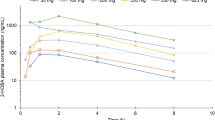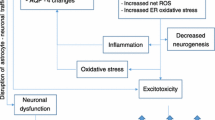Abstract
Pyritinol (pyrithioxine) is a combination of two molecules of vitamin B6 (pyridoxine) with disulfide linkage. Its pharmacokinetic profile mimics that of its parent compound. Because it crosses the blood–brain barrier, its major clinical utility is in brain-related disorders. Pyritinol regulates signalling pathways of various neurotransmitters including acetylcholine, γ-aminobutyric acid, N-methyl-d-aspartate, etc. Pyritinol has also been shown to act as an antioxidant and anti-inflammatory agent, and also reduces plasma viscosity. It is indicated in paediatric populations to treat learning disabilities, developmental dysphasia, postnatal hypoxia and other cognitive disorders. In adults, it is indicated for improving cognition and memory, Alzheimer’s disease, multi-infarct dementia and rheumatoid arthritis. It has also been investigated in many other clinical conditions, but results are inconclusive. The positive results of many animal studies have not been replicated into consistent clinical success. This review aims to discuss potential uses of pyritinol and its future prospects.
Similar content being viewed by others
References
Maria V, Albuquerque A, Loureiro A, et al. Severe cholestatic hepatitis induced by pyritinol. BMJ. 2004;328(7439):572–4.
Alkuraishy HM, Al-Gareeb AI, Albuhadilly AK. Vinpocetine and pyritinol: a new model for blood rheological modulation in cerebrovascular disorders—a randomized controlled clinical study. BioMed Res Int. 2014;2014:324307. https://doi.org/10.1155/2014/324307.
Liu JM, Wu PF, Rao J, et al. ST09, a novel thioester derivative of tacrine, alleviates cognitive deficits and enhances glucose metabolism in vascular dementia rats. CNS Neurosci Ther. 2016;22(3):220–9.
Jiménez-Andrade GY, Reyes-García G, Sereno G, et al. Pyritinol reduces nociception and oxidative stress in diabetic rats. Eur J Pharmacol. 2008;590(1–3):170–6.
Magnusson KR, Brim BL, Das SR. Selective vulnerabilities of N-methyl-d-aspartate (NMDA) receptors during brain aging. Front Aging Neurosci. 2010;2:11. https://doi.org/10.3389/fnagi.2010.00011.
Turský T. Pyritinol inhibition of the GABA and benzodiazepine receptor. Physiol Bohemoslov. 1988;37(5):417–26.
Seth SD, Seth V, editors. Textbook of pharmacology. 3rd ed. New Delhi: Elsevier; 2009.
Jebasingh D, Devavaram Jackson D, Venkataraman S, et al. The protective effects of Cyperus rotundus on behavior and cognitive function in a rat model of hypoxia injury. Pharm Biol. 2014;52(12):1558–69.
Jaiswal AK, Upadhyay SN, Bhattacharya SK. Effect of pyritinol, a cerebral protector, on learning and memory deficits induced by prenatal undernutrition and environmental impoverishment in young rats. Indian J Exp Biol. 1990;28(7):609–15.
Floersheim GL. Protection against acute ethanol toxicity in mice by zinc aspartate, glycols, levulose and pyritinol. Agents Actions. 1985;16(6):580–4.
Dayrens P, Ivanoff B, Cussac M, et al. Antiinflammatory and immunostimulant activities of six sulphur compounds—four benzenesulphonates, levamisole, and pyritinol hydrochloride—assayed in mouse cell activation studies. Arzneimittelforschung. 1983;33(3):372–7.
De Guibert C, Maumet C, Jannin P, et al. Abnormal functional lateralization and activity of language brain areas in typical specific language impairment (developmental dysphasia). Brain. 2011;134(10):3044–58.
Zavadenko NN, Kozlova EV, Koltunov IE. Developmental dysphasia: assessment of the drug treatment efficacy (in Russian). Zh Nevrol Psikhiatr Im S S Korsakova. 2012;112(7 Pt 2):90–5.
Zavadenko NN, Kozlova EV. Nootropic drug therapy for developmental dysphasia in children (in Russian). Voprosy Prakticheskoi Pediatrii. 2013;8(5):24–8.
Nair MK, George B, Jeyaseelan L. Pyritinol for post asphyxial encephalopathy in term babies: a randomized double-blind controlled trial. Indian Pediatr. 2009;46(Suppl):s37–42.
Zykov VP, Begasheva OI. Cognitive disturbances in patients with tics and Tourette’s syndrome and their correction with encephabol (in Russian). Zh Nevrol Psikhiatr Im S S Korsakova. 2003;103(11):10–4.
Zenkov LR, Zenkova AL. Encephabol in the treatment of cognitive disorders in epilepsy (in Russian). Zh Nevrol Psikhiatr Im S S Korsakova. 2011;111(5 Pt 2):77–80.
Hindmarch I, Coleston DM, Kerr JS. Psychopharmacological effects of pyritinol in normal volunteers. Neuropsychobiology. 1990–1991;24(3):159–64.
Mufson JE, Counts SE, Perez SE, et al. Cholinergic system during the progression of Alzheimer’s disease: therapeutic implications. Expert Rev Neurother. 2008;8(11):1703–18.
Ballinger E, Ananth M, Talmage DA, et al. Basal forebrain cholinergic circuits and signaling in cognition and cognitive decline. Neuron. 2016;91(6):1199–218.
Fischhof PK, Saletu B, Rüther E, et al. Therapeutic efficacy of pyritinol in patients with senile dementia of the Alzheimer type (SDAT) and multi-infarct dementia (MID). Neuropsychobiology. 1992;26(1–2):65–70.
Knezevic S. Pyritinol treatment of SDAT patients: evaluation by psychiatric and neurological examination, psychometric testing and rCBF measurements. Int Clin Psychopharmacol. 1989;4(1):25–38.
Herrmann WM, Kern U, Röhmel J. On the effects of pyritinol on functional deficits of patients with organic mental disorders. Pharmacopsychiatry. 1986;19(5):378–85.
Wiese JG, Shilpak MG, Browner WS. The alcohol hangover. Ann Intern Med. 2000;132:897–902.
Khan MA, Jensen K, Krogh HJ. Alcohol-induced hangover: a double-blind comparison of pyritinol and placebo in preventing hangover symptoms. Q J Stud Alcohol. 1973;34(4):1195–201.
Shah A, St. Clair EW. Rheumatoid arthritis. Harrison’s principles of internal medicine. 20th ed. New York: McGraw-Hill Education; 2018.
Lemmel EM. Comparison of pyritinol and auranofin in the treatment of rheumatoid arthritis. The European Multicenter Study Group. Br J Rheumatol. 1993;32(5):375–82.
Author information
Authors and Affiliations
Corresponding author
Ethics declarations
Conflict of interest
Authors declare no conflicts of interest relevant to this article.
Funding
No funding received from any source.
Rights and permissions
About this article
Cite this article
Singh, A., Purohit, V. A critical review of pyritinol. Drugs Ther Perspect 35, 278–282 (2019). https://doi.org/10.1007/s40267-019-00623-x
Published:
Issue Date:
DOI: https://doi.org/10.1007/s40267-019-00623-x




